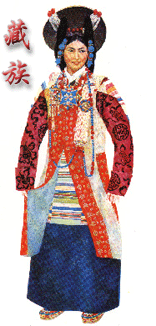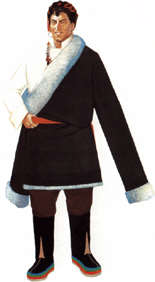| |
Tibetan Ethnic Group
( 2005-10-27 )
 The Tibetan ethnic group is one of the oldest in China. The people have their own written and oral language, and believe in TibetanBuddhism. The Tibetans mainly live in Southwest China'sTibetan Autonomous Regionwith the rest forming Tibetan communities in neighboring Qinghai, Gansu, Sichuan, andYunnan provinces. The Tibetans have produced vast collections of first class achievements in astronomy, medicine, literature, drama, painting, sculpture, and architecture. The Tibetan ethnic group is one of the oldest in China. The people have their own written and oral language, and believe in TibetanBuddhism. The Tibetans mainly live in Southwest China'sTibetan Autonomous Regionwith the rest forming Tibetan communities in neighboring Qinghai, Gansu, Sichuan, andYunnan provinces. The Tibetans have produced vast collections of first class achievements in astronomy, medicine, literature, drama, painting, sculpture, and architecture.
According to historical records, the Tibetans inhabited the Qingzang Plateau as early as 5,000 years ago. In the 7th century AD, the Tibetan king, Songtsan Gampo, unified the whole region and established the Tubo Dynasty (629-846). The marriage of this Tibetan king to Princess Wencheng from Chang'an (modern-day Xian, the then capital of theTang Dynasty(618-907)) and Princess Chizun from Nepal helped to introduce Buddhism and develop Tibetan culture.
Since its introduction to Tibet in the 7th century, Buddhism has developed unto a unique form in the area. Tibetan Buddhism, blended with Tibetan history and culture, has extended into every area of Tibetan life. Among the vast collections of the religious works and scriptures, the two most famous are Kanjur and Danjur. religious works and scriptures, the two most famous are Kanjur and Danjur.
Yaks, known as the "Boat of the Plateau," are essential to the life of the Tibetans. They are the major source of meat and milk, and they also serve as the means of transportation because of their tolerance of cold in the snowy mountains.
Zamba -- made from roasted highland barley mixed with butter, sugar and tea -- is a staple food for the Tibetans against the harsh weather.
The Tibetans wear various kinds of costumes made of silk, sheep's skin, wool, and cotton. Men's costumes are bold and loose, while women's are elegant and graceful. A man's robe is usually longer than his height; therefore, when he wears it, he has to lift the gown and tie it with a waistband, leaving the gown's bottom 30 to 40 centimeters above his feet. Women wear jewelry, mostly gold and silver. The sleeves of their shirts are usually longer than their arms and are used as a feature in Tibetan dances.
|
|

